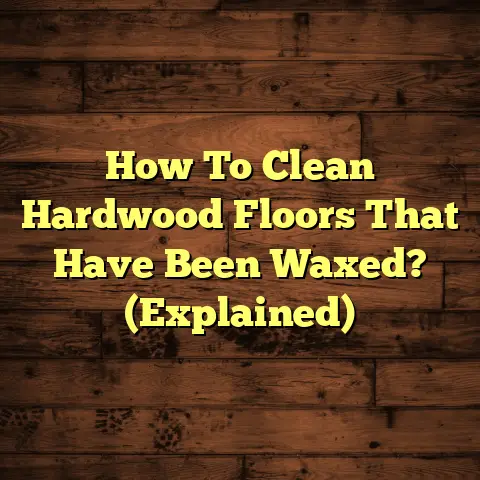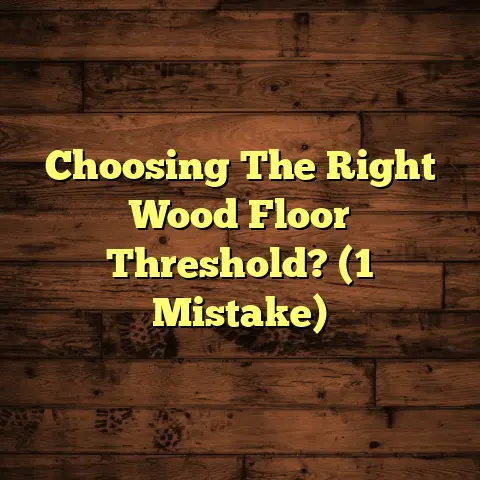Polyurethane Floor Cost? (Get A Quote!)
There’s something special about a well-finished floor, isn’t there?
It’s more than just a surface; it’s the foundation of your home’s entire vibe.
Flooring sets the stage for everything from cozy nights in to lively gatherings.
Think about it: the warmth you feel underfoot on a cold morning, the way sunlight reflects off a glossy surface.
It all contributes to the emotional connection we have with our homes.
That’s why choosing the right flooring is such a big deal.
Lately, I’ve been getting a lot of questions about polyurethane flooring.
It’s becoming a go-to for homeowners who want that sweet spot of beauty and brawn.
So, let’s dive deep into the world of polyurethane floors and, more importantly, what it’s going to cost you.
Section 1: Understanding Polyurethane Flooring
Okay, so what exactly is polyurethane flooring?
Simply put, it’s a synthetic resin used as a protective coating on floors.
Think of it as a shield that not only makes your floors look amazing but also guards them against the daily grind.
The composition is pretty straightforward: it’s a polymer formed by reacting an isocyanate with a polyol.
Sounds like science class, right?
But the magic is in the mix. This chemical reaction creates a tough, flexible, and durable finish.
Now, you’ve got two main types of polyurethane finishes to choose from: water-based and oil-based.
Water-Based Polyurethane:
- Characteristics: Low odor, dries quickly, and has a clear finish.
- Pros: Eco-friendly, doesn’t yellow over time, and easy to clean up.
- Cons: Can be less durable than oil-based, may require more coats.
Oil-Based Polyurethane:
- Characteristics: Strong odor, longer drying time, and an amber hue.
- Pros: Highly durable, moisture-resistant, and offers a rich, warm look.
- Cons: Strong fumes, yellows over time, and requires mineral spirits for cleanup.
I often recommend water-based for homeowners concerned about VOCs (volatile organic compounds) and quick turnaround.
But if you need maximum durability, oil-based is the way to go, no question.
The advantages of polyurethane flooring are hard to ignore:
- Durability: This stuff can take a beating. Scratches, scuffs, spills—polyurethane laughs in their face.
- Moisture Resistance: Perfect for kitchens and bathrooms where moisture is a constant threat.
- Ease of Maintenance: A quick sweep and mop, and you’re done. No fancy cleaning rituals required.
- Aesthetic Appeal: Whether you want a glossy shine or a matte finish, polyurethane can deliver the look you’re after.
So, how does the whole installation process work?
Well, it starts with prepping the floor.
This might involve sanding, cleaning, and repairing any imperfections.
Then, the polyurethane is applied in thin, even coats.
The number of coats depends on the type of finish and the level of protection you want.
Drying time is crucial, and you’ll need to keep foot traffic to a minimum during this period.
The timeline can vary depending on the size of the space and the type of polyurethane.
A small room might take a couple of days, while a larger area could take a week or more.
Section 2: Factors Influencing Polyurethane Flooring Costs
Alright, let’s get down to brass tacks: how much is this all going to cost you?
A lot of factors come into play, so let’s break it down.
1. Material Costs
The type of polyurethane you choose will significantly impact the price.
Water-based polyurethanes generally cost more per gallon than oil-based.
But remember, you might need more coats of water-based to achieve the same level of protection.
Here’s a rough idea of what you can expect to pay for materials:
| Material | Average Cost Per Gallon |
|---|---|
| Water-Based Polyurethane | \$40 – \$90 |
| Oil-Based Polyurethane | \$30 – \$70 |
| Polyurethane Wood Finish | \$20 – \$50 |
How does polyurethane stack up against other flooring options?
Here’s a quick comparison:
| Flooring Type | Average Cost Per Square Foot (Materials Only) |
|---|---|
| Polyurethane | \$2 – \$8 |
| Hardwood | \$5 – \$15 |
| Laminate | \$1 – \$5 |
| Tile | \$3 – \$20 |
As you can see, polyurethane can be a budget-friendly option, especially compared to hardwood or high-end tile.
2. Labor Costs
This is where things can get a little tricky.
Hiring professional installers will definitely add to the overall cost, but it’s often worth it.
Why? Because a pro will ensure the job is done right, minimizing the risk of bubbles, streaks, or other imperfections.
DIY is an option, but be prepared to invest time and effort.
And if you’re not experienced, you could end up with a less-than-perfect finish.
Labor costs can vary widely depending on your location.
In big cities like New York or Los Angeles, you can expect to pay more than in smaller towns.
Here’s a general idea of what you might pay for professional installation:
| Location | Average Labor Cost Per Square Foot |
|---|---|
| National Average | \$2 – \$5 |
| Major Metropolitan Areas | \$4 – \$8 |
3. Floor Size and Complexity
No surprises here: the bigger the area, the more materials and labor you’ll need.
But it’s not just about square footage.
The shape of the room also matters.
A simple rectangular room will be easier (and cheaper) to floor than a space with lots of nooks and crannies.
Stairs and transitions between rooms can also add to the cost.
These areas require extra attention to detail and can be more time-consuming to finish.
4. Preparation and Additional Treatments
Before you can even think about applying polyurethane, you need to prep the floor.
This might involve leveling uneven surfaces, repairing cracks or holes, and thoroughly cleaning the area.
These tasks can add to the overall cost, but they’re essential for a smooth, long-lasting finish.
Additional treatments, like staining or sealing, can also impact the price.
If you want to change the color of your floor or add an extra layer of protection, be prepared to shell out a bit more.
Section 3: Cost Breakdown
Okay, let’s put it all together and look at some real-world examples.
Detailed Cost Breakdown
Here’s a breakdown of what you can expect to pay for polyurethane flooring:
- Materials: \$2 – \$8 per square foot
- Labor: \$2 – \$5 per square foot
- Preparation: \$0.50 – \$2 per square foot (depending on the condition of the floor)
- Additional Treatments: \$0.50 – \$3 per square foot (depending on the treatment)
So, a complete polyurethane flooring project could range from \$4.50 to \$18 per square foot.
Now, let’s look at some specific examples:
- Living Room (200 sq ft): \$900 – \$3,600
- Kitchen (150 sq ft): \$675 – \$2,700
- Basement (400 sq ft): \$1,800 – \$7,200
These are just estimates, of course.
The actual cost will depend on the factors we discussed earlier.
Keep an eye out for seasonal or promotional pricing.
Flooring companies often offer discounts during certain times of the year, like spring or fall.
You might also be able to snag a deal during holidays like Black Friday or Labor Day.
Section 4: Getting a Quote
Ready to get some quotes? Here’s what you need to do:
Steps to Obtain Accurate Quotes
First, measure your space accurately.
Grab a tape measure and jot down the length and width of each room you want to floor.
Multiply those numbers to get the square footage.
It’s always a good idea to add a little extra (5-10%) to account for waste.
Next, research reputable contractors and installers in your area.
Check online reviews, ask for recommendations from friends and family, and make sure they’re licensed and insured.
Tips for Requesting Quotes
When you contact contractors, be prepared to provide the following information:
- Square footage of the area to be floored
- Type of flooring you’re interested in (polyurethane)
- Type of finish you want (water-based or oil-based)
- Any additional treatments you’re considering (staining, sealing, etc.)
- Your location
Don’t be afraid to ask questions!
Here are a few to get you started:
- What’s included in the quote? (Materials, labor, preparation, cleanup, etc.)
- How long will the project take?
- Do you offer a warranty?
- Can I see examples of your previous work?
Comparing Multiple Quotes
It’s crucial to get quotes from multiple contractors.
This will give you a better sense of the going rate in your area and help you identify any red flags.
Pay close attention to what’s included in each estimate.
Some contractors might offer a lower price but skimp on preparation or use cheaper materials.
Make sure you’re comparing apples to apples.
Section 5: Long-Term Value of Polyurethane Flooring
Okay, so you’ve spent the money and got your polyurethane floors installed.
What’s the long-term payoff?
Long-Term Cost Benefits
Polyurethane flooring is an investment that can pay off in the long run.
Its durability means you won’t have to replace it as often as other materials.
Compared to carpet, which might need replacing every 5-10 years, a well-maintained polyurethane floor can last 20 years or more.
You’ll also save on maintenance and repair costs.
Polyurethane is easy to clean and resistant to scratches and stains, so you won’t have to spend a fortune on special cleaning products or repairs.
Impact on Home Value
High-quality flooring can increase your home’s value and make it more marketable.
Polyurethane floors are a great selling point, especially if you choose a neutral color and a classic finish.
Potential buyers will appreciate the durability, low maintenance, and aesthetic appeal.
Environmental Considerations
If you’re concerned about the environment, water-based polyurethanes are a good choice.
They have lower VOCs than oil-based finishes, which means they’re less harmful to the air quality in your home.
Look for products that are certified by organizations like GreenGuard or FloorScore.
These certifications ensure that the product meets strict environmental standards.
Conclusion
So, there you have it: a comprehensive guide to polyurethane flooring costs.
As you can see, the initial investment can vary depending on a bunch of factors.
But the warmth, aesthetic appeal, and long-term value of polyurethane floors make them a solid choice for homeowners.
Now it’s your turn!
Take the next step in your flooring journey by seeking quotes and consulting with professionals.
Your dream floors are just a phone call away!
Remember, your home is your sanctuary.
Investing in quality flooring is an investment in your comfort, your lifestyle, and your future.
Happy flooring!





